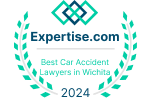Law Advantage
Were You Hurt in a Wreck at an Intersection?
Our car accident attorneys will fight the insurance companies
There are over 1000 intersections in the city of Wichita alone, with thousands more in surrounding communities in Sedwick County Kansas. Some are more dangerous than others, but serious and even fatal car accidents can occur at any intersection. Drivers on the road need to pay attention and follow the rules of the road when they arrive at an intersection.
There are many types of intersections. Each type of intersection has different rules for drivers. Some types of intersections are open intersections, intersections with stop signs (this can be from one to four or more stop signs), intersections with traffic signals, intersections with merge or yield signs, intersections with railroads, intersections with alleys, intersections with pedestrian crosswalks, any there are others.
Intersections can be confusing, but the legal situation after an intersection wreck can be more confusing still. The insurance company will try to make it even more confusing when they try to get a recorded statement from you and the witnesses. Don’t talk to them! We fight back. PISTOTNIK LAW knows how to handle all intersection accidents and build a strong case that the insurance company can’t ignore. Schedule your free consultation with a Wichita car accident lawyer today.
Who Is at Fault for an Open Intersection Car Wreck?
When two drivers approach an intersection that has no stop signs, no yield signs and no traffic signals, and they collide, the insurance companies always assert comparative fault.
These auto accidents typically have the same arguments for the drivers. In Kansas, the driver on the left is required to yield right of way to the driver on the right (assuming they approach the intersection at the same time). The driver on the right will argue the driver on the left was at fault. A Kansas judge will typically instruct a jury: “The laws of Kansas provide that when two vehicles approach or enter an intersection from different highways at approximately the same time, the driver on the left shall yield the right of way to the vehicle on the right.” Pattern Instruction of Kansas 121.28.
However, the law also states the driver who is at the intersection first has control of the intersection and the other driver must yield right of way to them.
When you look at any intersection, the driver on the left may enter the intersection first and therefore the driver on the right should yield to them.
Of course, the speed of the vehicles is important. The manner that each driver took to keep a proper lookout is important. The evasive action of each driver is important. Whether or not there were obstructions that may have interfered with the view of each driver is important. Legally, if your view was obstructed, you should slow down and drive with due care.
The individual facts of each auto accident will vary just like the intersections themselves will all be unique.
Insurance companies may not know all the facts and be quick to label the driver on the left to be at fault. Their decision is not binding and ultimately a judge or jury determines fault, not the insurance company.
Who Is at Fault When the Intersection Has Traffic Signals?
Common sense tells us this shouldn’t be a confusing issue. But, every law seems to have exceptions. Normally whoever has the green light has the right of way and whoever runs a red light is at fault. The law is straight forward: “The driver of a vehicle approaching a green light may proceed straight through, or turn right or left, unless a sign prohibits either turn. But if there are other vehicles or pedestrians lawfully within the intersection or an adjacent crosswalk, the driver must yield the right of way.” Pattern Instruction of Kansas 121.10(A). This law discusses the exception that if another vehicle or pedestrian has control of the intersection because they are already lawfully in the intersection, the driver can’t legally proceed, even with a green light.
A common wreck at intersections with traffic signals involves a driver turning left on a green turn arrow. The driver proceeds with the left turn when the arrow light is about to end or change to yellow. The oncoming driver is timing the red light to proceed as quick as possible when the light turns to a solid green circle. The law in these situations is: “The driver of a vehicle approaching a green arrow may enter the intersection cautiously, but only to move in the direction of the arrow. But if there are other vehicles or pedestrians lawfully within the intersection or an adjacent crosswalk, the driver must yield the right of way.” Pattern Instruction of Kansas 121.10 (B) The argument for each driver is that the driver with the arrow was not being cautious and looking out for other traffic. Also if the arrow did turn to yellow or change to a solid green circle, or even a solid red circle, the driver that had the arrow is no longer legally allowed to enter the intersection or proceed with the left turn. If the driver turning left proceeds with the left turn after the arrow is gone, that driver is failing to yield right of way. Of course, if the oncoming driver is timing the light to proceed on green, they have a duty to yield right of way to the vehicle turning left if the left turn has started prior to the change of the light.
And of course, another common auto accident happens when the traffic signals allow a left turn on a solid green circle. The same law applies to left turns at intersections without traffic signals. The law states: “The laws of Kansas provide that the driver of a vehicle intending to turn to the left within an intersection or into any alley, private road or driveway shall yield the right of way to any vehicle approaching from the opposite direction which is within the intersection or so close thereto as to constitute an immediate hazard.” Pattern Instruction of Kansas 121.30. It is a matter of judgment as to whether or not the oncoming vehicle is within the intersection or so close thereto to be an immediate hazard. This obviously varies depending upon the speed of the approaching vehicle, including which lane that vehicle is using.
All Intersection Auto Accidents Are the Result of Negligence
Two of the most common causes of intersection car wrecks are disobeying traffic signals and failing to yield the right of way. People who run red lights, accelerate to push through yellow lights, or don’t pay attention to the traffic signs and signals are a risk to everyone on the road. Likewise, failing to yield the right of way, especially when making a left turn or going right on red, can cause crashes.
Distracted driving is a serious problem at intersections. Many motorists use their cell phones while stopped or even while approaching intersections. Cell phone use causes cognitive distraction. This means that the person’s train of thought is interrupted. Even when looking at the roadway, the person’s mind is still thinking about the last thing seen on the cell phone.
Drunk driving also contributes to intersection crashes. Many substances can impair judgment, and when the drunk driver has to make split-second decisions or recognize that another driver has the right of way, they simply don’t have the awareness to do so.
Fatigue and falling asleep at the wheel can be incredibly dangerous at intersections for the same reason. Imagine another driver who has been driving for many hours or a driver who hasn’t been able to sleep for days, and the inability to focus on driving.
Finally, some drivers cause wrecks by aggressive driving – whipping in and out of traffic or driving at excessive speeds prevents the driver from following the rules of the road at intersections.
Intersection Wrecks Require a Thorough Investigation
Sometimes with intersection accidents it’s unclear who was at fault. Both drivers claim to have had a green light. Witnesses may disagree on what color the light was or who had the right of way. Insurance companies take advantage of this confusion to dispute paying valid claims. In Kansas, the insurance companies may try to argue both drivers have 50% fault and then they can deny claims of both drivers.
Another problem is that the injuries with intersection car wrecks are often severe, especially when someone is T-boned (as the side of a car provides much less protection than the front or back) or the crash involves a biker, cyclist, or pedestrian. The more serious the injuries, the more costly the potential claim, which means the insurance company has an added financial incentive to dispute or deny the claim.
We know how to overcome those challenges through thorough investigation. Our attorneys interview witnesses and investigate the other driver’s stories to get to the bottom of what really happened. We know experts, such as accident reconstructionists, who can provide expert guidance on how the wreck occurred. We work to build a case that the insurance company can’t ignore. We know Kansas law, we know the Segwick County courts, and we don’t hesitate to put in the work to get full and fair compensation for our clients.
Count On Pistotnik Law to Guide You Through the Process
Getting compensation for an intersection accident can take time. The valule of your case changes depending upon what treatment you receive. You need to get quality medical treatment and find out the full extent of your injuries. Depending on the position the insurance company takes, this may take a few months or can take much longer. We can’t promise a fast resolution, but we can promise to take efforts to expedite your case and keep you informed every step of the way.
We represent intersection accident victims on a contingency fee basis, which means you pay us nothing up front and nothing out of pocket. Our firm pays the costs to move your case forward. If we win, our fee is a percentage of the money we recover for you; if we don’t win, we don’t get paid.
Get the representation you need to fight for the compensation you deserve. Contact us today to discuss your legal options with an experienced intersection accident lawyer. There’s no cost and no obligation, but we guarantee we will inform you of your legal rights.









